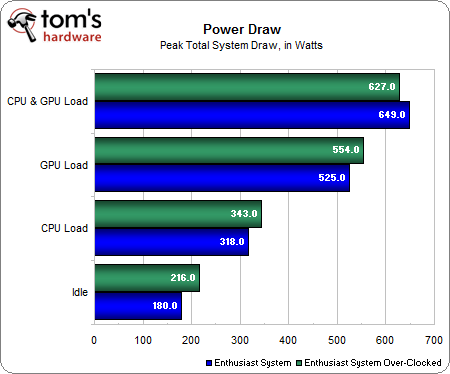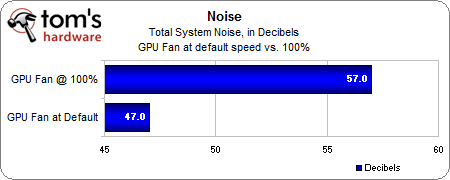System Builder Marathon, May '09: $1,300 Enthusiast PC
Power And Noise Benchmarks
The power consumption benchmarks were very close, as we actually lowered CPU voltage to get our higher overclock. As well, we weren’t really able to overclock the graphics cards to a noteworthy level without running into heat issues.
The only curious result was the peak concurrent CPU and GPU peak load test, which showed our overclocked system used less power than the stock system did. We repeated these tests a number of times with the same results and paid close attention to the CPU and GPU clock speeds to make sure that everything was running at full speed. Still, we kept getting identical results.
This is a benchmark we thought was important to include, to demonstrate the trade-off we had to make for system stability. At stock graphics card fan speeds, the system would sometimes crash during 1920x1200 benchmarks, especially if AA was applied. To counter this, we increased the graphics card fan speed to 100% using the Nvidia System Tool, which gave us the stability we needed, but at a high cost to the amount of system noise. The end result was that our quiet Micro-ATX system became quite loud.
In retrospect, if we were to live with this system on a daily basis, we might choose to make a compromise: increasing the fan speed by a small amount, and even decreasing the graphics cards clock speeds by a small amount as well, perhaps to reference GeForce GTX 260 levels. As the benchmarks show, a slight increase or decrease in graphics card clock speeds has a negligible effect on graphics performance, but it can have a marked effect on stability. Slowing it down a bit while speeding up the fans a small amount would likely supply us with solid stability and have a negligible impact on performance, supplying a quieter and more tolerable long-term solution.
Get Tom's Hardware's best news and in-depth reviews, straight to your inbox.
Current page: Power And Noise Benchmarks
Prev Page Benchmark Results: Stalker: Clear Sky Next Page ConclusionDon Woligroski was a former senior hardware editor for Tom's Hardware. He has covered a wide range of PC hardware topics, including CPUs, GPUs, system building, and emerging technologies.
-
jtnstnt It looks like you guys have a fetish for silverstone sff cases, and small motherboards. You guys probably like other small things...Reply -
one-shot Was the peak power draw measured from the wall? If so, do you know the efficiency of the PSU to determine the approximate power draw from the components at a given level of output? Overall, great article. I hope my 650Watt PSU with 3 X 19A 12V rails can handle another GTX 260 Core 216.Reply -
serifus if you wanted to go SFF it would be nice to see one done in an LIAN-LI PC-A05NB. at least you still get the full atx boards in those.Reply -
SpadeM ReplyThis system is no slouch and cuts through our new gaming benchmarks like a hot knife through butter.
I wonder how exactly does the selection of components go. I mean it seems that there's some attention given to the forums to be politically correct, but that's kind of it. For $1300 a Phenom 2 + micro AM3 board + 2x4890 in crossfire is a much better solution so .. why not choose the better option?
-
capttylor34 That system looks quite crowded on the inside, and that Dark Knight is big for a regular sized system, I'm actually kind of impressed you managed to fit it in a Micro ATX at all. I suppose as long as it runs stable, theres really no problem. Still think the articles should be titled "Micro System Build-off" just to let people know off the bat what they're about to read.Reply -
IzzyCraft SpadeMI wonder how exactly does the selection of components go. I mean it seems that there's some attention given to the forums to be politically correct, but that's kind of it. For $1300 a Phenom 2 + micro AM3 board + 2x4890 in crossfire is a much better solution so .. why not choose the better option?Reply -
armistitiu I'm tired of seeing I7 920 in every damn "recommended" PC. I'm not saying go AMD but please just try to vary them a bit it's getting stupid. Also try building your own benchmarks or at least change them once in a while.Reply
Btw i\m getting tired of people picking up I7 and saying "because i do heavy CPU tasks" (not necessarily IzzyCraft ) and in fact all they need is a browser,OpenOffice and WoW minimized in the taskbar.
The article is well done no doubts but try using other brands also. It\s starting to sound biased.
-
ohim This article would be great if you could do : what you can buy for 1300 Intel parts and what you can by for 1300 AMD parts ... and put the 2 PCs to compeat to eachother :P it would be a more interesting article than just buy a pc and ... show what ?Reply -
nerrawg Nice slick system this - looks like 2 x 260's is pretty good value at 1920 x 1200 for those that want to max out the settings in the most demanding games. Was wondering however if there is a good technical explanation for the power consumption results because they seem pretty strange?Reply


